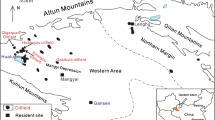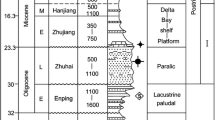Abstract
The present paper deals with the biomarker characteristics of crude oils and source rocks from different environments (fresh, fresh-brackish and salt waters) of nonmarine depositional basins of different ages in China. Their characters are summarized as follows: 1 ) Source rocks and crude oils derived from fresh-water lacustrine facies have an odd / even predominance of n-alkanes and high pristane / phytane ratios. Oils from the fresh-water lacustrine fecies differ from typical marine oils in the relative contents of total steranes and terpanes, the concentrations of hopanes and organic sulphur compounds and the values of methylphenanthrene indices and C, H, S stable isotopes. 2) The source rocks and crude oils derived from saline lacustrine fecies possess an even / odd predominance of n-alkanes and high phytane / pristane ratios. There are also some differences between saline lacustrine oils and freshwater lacustrine oils in the concentrations of steranes, tricyclic terpanes and organic sulphur compounds, as well as in the values of methylphenanthrene indices and C, H, S stable isotopes. 3) Oils derived from fresh-brackish water lake facies differ from oils from fresh-water lacustrine or saline lacustrine environments in respect of some biomarkers. According to the various distributions of these biomarkers, a number of geochemical parameters can be applied synthetically to differentiating and identifying the nature of original depositional environments of crude oils and source rocks and that of organisms — primary source materials present in those environments.
Similar content being viewed by others
References
Aquino Neto, F. R., Restle, A., Connan, J., Albrecht, P. and Ourisson, G. (1982) Novel tricyclic terpanes (C19, C20) in sediments and petroleums.Tetrahedron Lett.,23, 2027–2030.
Chappe, B., Michaelis, W. and Albrecht, P. (1980) Molecular fossils of archaebacteria as selective degradation products of kerogen.In Advances in Organic Geochemistry 1979, eds: A. G. Douglas and J. R. Maxwell, Oxford, England, 265–274.
Ekweozer, C. M. and Strausz, O. P. (1982) 18, 19-bisnor-13 (H), 14 (H)-cheilanthane: A novel degraded tricyclic sesterterpenoid hydrocarbon from the Athabasca oil sands.Tetrahedron Letts.,23 (27), 2711–2714.
Fan Pu, Wang Tieguan and Swain, F. M. (1985) Geochemical characteristics of crude oils and source beds in different continental facies of four oil-bearing basins, China.Proceedings of International Conference on Lacustrine Petroleum Source Rocks, London, 1985, edited by A. J. Fleet, K. Kelts and M. R. Talbot, 309–326.
Fan Pu (1988) The characteristics of biomarker compounds in Chinese crude oils.Proceedings of the First International Conference on Petroleum Geochemistry and Exploration in the Afro-Asian Region, DehraDun, 1985. 197–202.
Fan Pu and Claypool, G. E. (1988) A study on δ 13 C, δ 34 S and δD of crude oils.Proceedings of the First International Conference on Petroleum Geochemistry and Exploration in the Afro-Asian Region, DehraDun, 1985. 207–211.
Fan Pu, Luo B., Huang R., Shen P., Hui R., Shao H., Wang Y. and Rong G. (1980) Formation and migration of continental oil and gas in China (1).Scientia Sinka,23 (10), 1286–1295.
Fu Jiamo and Sheng Guoying (1989 ) Biological marker composition of typical source rocks and related crude oils of terrestrial origin in the People ’s Republic of China: a review.Applied Geochemistry,4, 13–22.
Goossens, H., De Leeuw, J. W., Schenck, P. A. and Brassell, S. C. (1984) Tocopherols as likely precursors of pristane in ancient sediments and crude oils.Nature,312, 440–442.
King, J. D. (1982) Geochemical data processing with the DS-50 data system.American Society for Mass Spectrometry, Extended Abstracts.
Mello, M. R., Galgianone, P. C., Brassell, S. C. and Maxwell, J.R. (1988) Geochemical and biological marker assessment of depositional environments using Brazilian offshore oils.Marine Petrol. Geol.,5, 205–221.
Philp, R. P., Li J. and Lewis, C. A. (1989) An organic geochemical investigation of crude oils from Shangganning, Jianghan, Qaidam and Junggar basins, the People ’s Republic of China.Org. Geochem.,14 (4), 447–460.
Radke, M., Weite, D. H. and Willsch, H. (1982) Geochemical study on a well in the western Canada Basin: relation of the aromatic distribution pattern to maturity of organic matter.Geochim. Cosmochim. Acta,46 (1), 1–9.
Volkman, J. R. (1986) A review of sterol markers for marine and terrigenous organic matter.Org. Geochem.,9, 83–99.
Author information
Authors and Affiliations
Rights and permissions
About this article
Cite this article
Pu, F., Jinggui, L. Characteristics of the biomarkers from nonmarine crude oils in China — A review. Chin. J. of Geochem. 10, 131–139 (1991). https://doi.org/10.1007/BF02837713
Issue Date:
DOI: https://doi.org/10.1007/BF02837713




